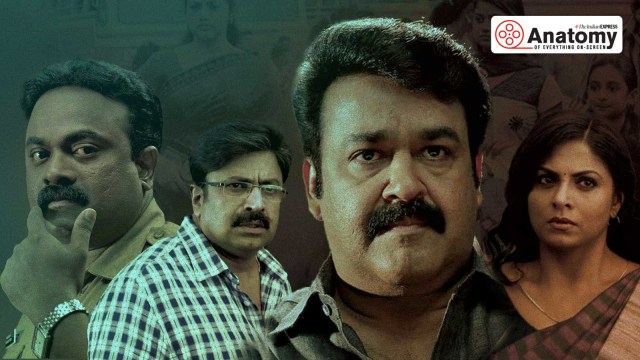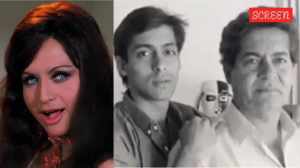Just as the year was coming to a close, the trailer of a movie helmed by Jeethu Joseph, known for Memories (2013), My Boss (2012) and Detective (2007), arrived. However, the trailer failed to generate significant anticipation as it appeared rather sombre. Set against a backdrop of somewhat cheerful music, it immediately revealed that Mohanlal’s character in the film was not larger-than-life but a simple villager, reminiscent of his roles in Sathyan Anthikad movies. The majority of the promo showcased endearing moments between Mohanlal’s character, his wife, two daughters and a couple of other characters. Even as the video approached its conclusion, it only conveyed that the film centred around a family encountering “a few hurdles”, much like any other drama.

Nevertheless, the film’s title and tagline, Drishyam: Visuals can be deceiving, coupled with Mohanlal’s final dialogue, “fear and tension will land us in trouble,” hinted at something more significant. Despite this, the film failed to generate much hype and its promotions remained relatively low-key. A few posters featuring Mohanlal peering through the leaves of a tree adorned various parts of Kerala, leading people to conclude that 2013 wasn’t Mohanlal’s year.
December 19, 2013: It was a Thursday during the Christmas exam season for students in Kerala. Consequently, initial screenings of the film transpired without creating significant ripples. However, word slowly began to spread that Drishyam (Visual) was a ‘good’ movie. By evening, the entire state was buzzing with the film’s title, prompting people to flock to theatres to witness this new Mohanlal flick that had captivated those fortunate enough to have seen it. The enthusiasm reached new heights and after the 6 pm shows concluded, social media platforms, especially Facebook which was in vogue at that time, were inundated with posts beginning or ending with phrases like “Drishyam is remarkable,” “Drishyam is mind-blowing” and “Drishyam is unparalleled”. Thus began the illustrious history of the most influential and impactful Indian film in recent times.
One of the key reasons why Drishyam’s story resonated with audiences instantaneously is because, as Jeethu Joseph maintained during a chat with The New Indian Express right before the film’s release and time and again following that, it’s “a complete family drama”. In contrast to many films of its time set in the urban surroundings of Kochi, Drishyam unfolds in the quaint locality of Rajakkad, shot entirely in Thodupuzha amidst the captivating landscapes of Idukki district. Had the film been placed in an urban setting with accordingly altered developments, it remains uncertain whether Drishyam would have had the same impactful effect.
“Drishyam is a complete script-oriented film that does not require any special effort (unlike Memories). We shot the film- sticking completely to the script,” Jeethu pointed out in the TNIE interview. Despite the film not featuring many nail-biting moments prior to the inciting incident — which arrives almost 50 minutes into the film’s runtime with Varun Prabhakar (Roshan Basheer) reaching Rajakkad and threatening Anju (Ansiba Hassan) with a hidden camera video of her showering (an aspect of the film that has been subjected to rightful criticism over the years) — Jeethu manages to adeptly lay the groundwork, providing glimpses into the family, its dynamics, the members’ characteristics and the nature of the locals, keeping the audiences engaged as the story unfolds at a measured pace.
Thoughtfully integrating various elements, such as Georgekutty’s (Mohanlal) deep passion for cinema, his intimate moments and “playful” banters with his wife Rani (Meena), their connection with daughters Anju and Anu (Esther Anil), Georgekutty’s camaraderie with his employee Monichan (Neeraj Madhav), local tea stall owner Sulaiman (Kozhikode Narayanan Nair) and head constable Madhavan (Kunchan), along with his frequent conflicts with constable Sahadevan (Kalabhavan Shajon), Jeethu ensures that the script is intricately woven yet maintains an apparent sense of joy.
Story continues below this ad
Employing deliberate settings in mostly small rooms or confined spaces, with minimal use of long shots, Jeethu emphasises the compactness of the world, creating a perfect, unwavering impression in viewers about the world and the narrative.
However, the narrative takes a turn right after Georgekutty utters the line, “Why should I fear the police? I haven’t done anything against the law until today. Neither do I intend to ever,” immediately triggering a sense that something ominous is impending among audiences, who find themselves sub/consciously anticipating it, just before Varun reenters the scene. By astutely providing audiences with a fair indication of what is about to unfold, Jeethu ensures that viewers are not taken aback by the forthcoming action, but rather intrigued by the manner in which it transpires. This is a testament to the brilliance of Drishyam, where while many elements are somewhat predictable, the impact lies in meticulous crafting and concealment. Again, if the sole focus had been on the crime, Drishyam would have been just another usual crime drama, but the film’s true allure lies in how adeptly Georgekutty erased his traces.
As the film unfolds, we witness every move Georgekutty makes, observing how he instructs his family to genuinely adopt and repeatedly recite the latest version of the life story he has crafted. We, too, become part of this learning process, internalising the narrative that we were “attending a sermon at Parel church in Thodupuzha on August 2 and returned only the next evening.”
We also hear Georgekutty cautioning us and Rani, stating, “This is a risky game. We may win or lose,” while emphasising, “Neither you nor our children will go to jail over this.” The constant assurance in these words adds depth and impact to Drishyam. While being sure about the truths and lies, our focus remains on how each character presents them and how the police interpret them. Even as we assume the role of sleuths here, Jeethu ensures that we do not align with the cops and that we remain loyal to the “victims” by effectively evoking sympathy from viewers, even though we are well aware that they committed murder and are now trying to erase the evidence. Simultaneously, another way in which Jeethu’s narrative garners support for Georgekutty and his family is by highlighting the inherent superiority complex and cunningness displayed by the police from the beginning. “He is just a villager who hasn’t even completed high school,” says IG Geetha Prabhakar (Asha Sharath), further underscoring this point.
Story continues below this ad
The exceptional quality of Drishyam becomes evident when, even when Rani, Anju and Anu believe that everything has concluded peacefully, Georgekutty remains certain that the police will return — a sentiment shared by the viewers, who, in their omnipresence within the narrative, anticipate the same. This aspect too contributes to the overall excellence of Drishyam.
Meanwhile, in the third act, we gradually comprehend why the film earned its rightful title Drishyam as Georgekutty visually reconstructed August 2 and 3, skillfully engraining these recreated visuals into the memories of those around him, effectively erasing the existing recollections. These moments propel Drishyam to its peak, radiating a profound sense of awe — a quality seldom found in Indian thrillers.
For audiences already captivated by the film’s tightly woven script, Jeethu delivers a huge blow with the climax reveal, marking the official birth of an all-time blockbuster.
Though Drishyam cannot be considered a cinematic masterpiece that radiates technical brilliance, the film serves as evidence of how a brilliant script can elevate a movie. It demonstrates an excellent script’s ability to help viewers overlook the movie’s evident and abundant flaws without any reservations.
Story continues below this ad
10 years, six remakes (with another two in the pipeline, including Indonesian and Korean), one sequel, and three remakes to the sequel later, Drishyam continues to generate discussions, primarily focusing on its subsequent third part, as well as its script and the problematic core. Therefore, it remains to be seen whether, a decade from now, when Drishyam turns 20 in 2033, the film will have aged as gracefully and continue to inspire positive conversations about it, although this prospect seems doubtful.




































